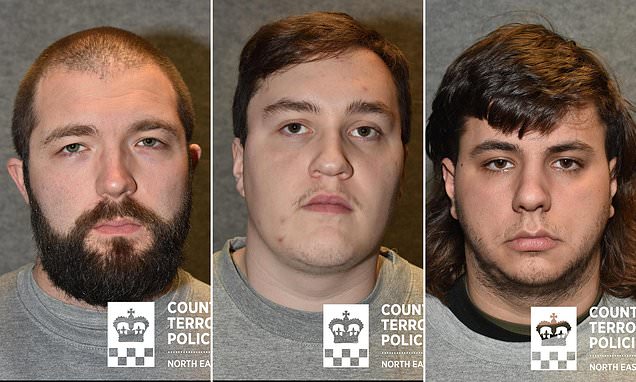What looked like chatter on encrypted apps turned out to be a plan.
Counter-terror detectives picked up threads of extremist talk that, when pieced together, showed three men moving from hateful fantasy to practical preparation for attacks on religious sites.
Their discussions and activity were enough for police to step in — and for a court to later hand down lengthy sentences.
The group and the sentences
Sheffield Crown Court heard that Christopher Ringrose (34), Marco Pitzettu (25) and Brogan Stewart (25) had been building a far-right cell online and stockpiling weapons.
The judge sentenced them to a total of 29 years behind bars — Ringrose 10 years, Pitzettu eight years and Stewart 11 years — after finding they had prepared acts of terrorism and collected information that could help attackers.
How their obsession turned practical
All three came from different parts of the country (Staffordshire, Derbyshire and West Yorkshire) but shared a fixation with Nazi ideology and violence.
Prosecutors told the court they glorified mass killers, swapped racist abuse and fantasised about harming people of particular faiths and backgrounds.
By early 2024 they had begun flagging specific targets, with one potential location identified in Leeds.
Roles, recruitment and a chilling cache
Stewart was described as the ringleader; he named Ringrose and Pitzettu his “armourers” and pushed them to make or source firearms and explosives.
When police executed searches they found a frightening collection: machetes, swords, crossbows, an illegal stun gun and components for a semi-automatic weapon.
Ringrose had 3D-printed many of the parts for a homemade assault rifle and the men were looking for the remaining pieces to complete it.
The plot was born online
The trio had never actually met face-to-face before their arrest — their “cell” existed online, where they shared Nazi imagery and violent propaganda.
The judge explained the group had been planning an attack on an Islamic education centre in Leeds when counter-terror teams intervened.
She accepted that while the attackers hadn’t settled every last detail, a terrorist strike was likely in the near future if the plot hadn’t been uncovered.
What they told the court versus what evidence showed
During the trial the defendants tried to frame their preparations as readiness for extreme collapse scenarios — a “sht hits the fan” moment such as a foreign invasion or even a fictional zombie apocalypse.
Prosecutors countered that their real aim was racial violence: they discussed targeting religious centres and asylum hotels, and actively sought to recruit others and broaden their arsenal.
Disturbing messages and plans
Court documents revealed chilling messages from Stewart — who styled himself a “stay at home domestic terrorist” — calling for violent action, praising extremist figures and even fantasising about torturing a local imam.
He created a Telegram group named Einsatz 14, a phrase tied to Nazi death squad mythology, and issued orders to plan attacks on migrants.
The group set a date for a woodland training session in Derbyshire to “cement that brotherhood,” although bad weather cancelled the meetup and police arrested them shortly after.
The homemade rifle and online how-to manuals
Ringrose used a readily available Creality 3D printer to manufacture most of a weapon known from online communities as the FGC-9 Mk II — a design distributed as a set of computer files by an individual tied to anti-surveillance rhetoric.
The version seized was missing a barrel and firing pin, but the men were actively sourcing parts to finish it.
Videos found on Ringrose’s devices showed he had made key components and had access to blank-firing ammunition.
Personal details and the picture at home
Images released by police painted a jarring contrast: Stewart’s bedroom contained childlike wall decals alongside a Nazi flag and white supremacist posters.
Ringrose — a car-parts manager whose partner was pregnant with their second child — posted a photo of his one-year-old wearing a skull mask linked to the far right with the slogan “choose violence.”
Pitzettu, a mechanic, had shared videos of previous mass attacks.
The court heard how all three had glorified killings and planned to escalate their stockpile to more lethal items.
The judge’s view and the takeaway
Mrs Justice Cutts told the court that authorities had monitored and ultimately stopped their plans before they could go further; while she did not judge the attack to have been imminent in the sense of a fully formed, immediate operation, she concluded an attack was likely in the not-too-distant future if left unchecked.
In short: monitoring and intervention prevented a serious act of far-right terrorism, but the evidence showed this cell was moving from hateful talk to lethal preparation.
Share on Facebook «||» Share on Twitter «||» Share on Reddit «||» Share on LinkedIn